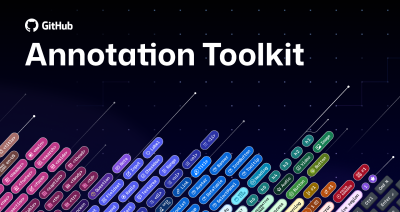Now more than ever, teams should be quickly evolving to keep up with the ever-changing landscape of software development.
Think about it: how else can company leaders maintain a competitive edge within their industries? Take the banking industry, for example. In a matter of years, we’ve gone from in-person transactions, to ATMs, to online, to mobile. Now, people can deposit and withdraw money in seconds. And when it comes to paying: we’ve gone from swiping a card to inserting a chip, tapping to pay, and then being able to pay with your phone or watch. This is how fast technology is accelerating.
GitHub has many solutions to solve challenges that companies face every day. For open source development, you’re probably already familiar with GitHub’s free tier. But there are also solutions specifically for teams, like GitHub Enterprise.
GitHub Enterprise meets your company where you are, available in the cloud or on-premises.
Throughout this post, we’ll explore four challenges impacting businesses today—and how GitHub Enterprise can help.
Teamwork is important, but coordination is hard. This was a clear insight from our recent State of the Octoverse report. Only 11% of respondents expect to go back to working colocated, which is a 30% decrease from previous results. But fortunately for enterprises, the open source community has already solved the challenge of collaborative working at a global scale by leaning on GitHub.
By using pull requests, branch policies, discussions, and more, you can replicate those open source practices within your organization using innersource.
As the tech landscape continues to evolve, leaders are adding additional tools to keep up. This creates a sprawl of technologies that internal engineering teams have to then manage, making their focus “maintaining velocity” instead of increasing it and delivering value to end users.
As a centralized platform that developers already know and love, GitHub Enterprise empowers engineering teams from the planning stages of the development cycle all the way through to release.
Development starts at the planning stage. Planning typically happens across multiple tools, teams, and locations. In GitHub, you can use GitHub Issues for simple project management, associate metadata labels to these issues, and crosslink issues across teams. To visualize these tasks at a project level, there’s GitHub Projects. And when there’s a need to facilitate discussions within or across teams, you can use GitHub Discussions. All of this is accessible within one of GitHub’s most well known features to a developer, GitHub Repositories!
But, before you merge code into your main branch, you need to be sure that certain standards have been met, so that you’re building quality applications. Checks and balances are key to making sure that you’re staying on track. This is where GitHub Actions comes in. GitHub Actions is GitHub’s answer to automating workflows. By cutting down time doing administrative tasks, developers can focus on what matters most.
Did you know that you’re not just limited to Continuous Integration/Continuous Delivery, but can also automate based on other GitHub events like labeling a GitHub issue, or adding a comment to a new issue?
Additionally, GitHub Enterprise has the unique ability to integrate with all your favorite tools, which minimizes context switching and friction. This allows developers to focus not on simply keeping the lights on, but delivering innovative software to your users.
At a time when the industry is encountering a developer skills shortage, it’s crucial to focus on increasing the productivity of your developers, providing them with an environment where they can thrive and do their best work. Here at GitHub, developer experience is one of our key areas of focus because we know that software development is linked to business performance.
Consider developer onboarding—setting up a new development environment can be a painful experience. If the process is well documented and all goes smoothly, your new developer may get their new machine set up in hours. Worst case, they may be unproductive for days. This isn’t just frustrating for the developer, but also for the engineering leads who go through this process for every new teammate.
To help solve this challenge internally at GitHub, we migrated our engineering team to Codespaces, so new hires can go from zero to a functioning development environment in less time than it takes to install Slack.
Let’s not forget about the importance of recruiting new talent into organizations. The next generation of developers joining our companies are already using GitHub: students! GitHub Education has already touched 4.3 million students, through programs such as Global Campus, GitHub Campus Experts, the Student Developer Pack, GitHub Classroom and more.
Developer experience isn’t just about productivity. Providing a working environment in which your developers are happy, can thrive, and feel empowered to do their best work is equally important.
To help new talent easily get started, it makes sense to invest in the tools that they love, contributing to their happiness and overall developer experience.
GitHub’s CEO, Thomas Dohmke previously said:
Because when you can do what you love, better, easier, with more help, this creates a pathway for your happiness. And everyone, not just developers, should care about developer happiness.
We’ve all been in a project that’s approaching the go-live date, but a security review causes delays. The problem here is not the security team. The problem is that security was an afterthought, rather than being integrated into the entire development lifecycle. GitHub prioritizes security from the start, with a native, first-party tool unlike others.
This is especially important in a climate where security is of ever growing importance. Consider the recent Log4J event. If organizations had a clearer strategy to managing software dependencies, then some of these challenges could have been mitigated much more quickly. This is where tools like Dependabot can help organizations take control of their open source dependencies.
There are also tools like GitHub Advanced Security, which has built-in secret scanning capabilities to identify secret leakage (It’s painful, we’ve all been there!), and code scanning capabilities directly within your repository. No separate security tools or external views needed. And the best part: you can integrate with several third-party providers or use GitHub’s own code analysis engine, CodeQL.
This post is just scratching the surface of everything businesses can do to level up with GitHub! Stay tuned for further blog posts in the near future, where we’ll explore how GitHub Enterprise can enable your organization with modern engineering methods and empower your development teams to do their best work.
To jump ahead, check out our recently published eBook on how to transform your business in a digital world. Want to get going even quicker? Then get started with a GitHub Enterprise trial today!
Written by
Chris is a passionate developer advocate and senior program manager in GitHub’s Developer Relations team. He works with execs, engineering leads, and teams from the smallest of startups, established enterprises, open source communities and individual developers, helping them ❤️ GitHub and unlock their software engineering potential.



